
Earwigs make up the insect order Dermaptera. With about 2,000 species in 12 families, they are one of the smaller insect orders. Earwigs have characteristic cerci, a pair of forcep-like pincers on their abdomen, and membranous wings folded underneath short, rarely used forewings, hence the scientific order name, "skin wings". Some groups are tiny parasites on mammals and lack the typical pincers. Earwigs are found on all continents except Antarctica.

Pygidicranidae is a family of earwigs, formerly placed in the suborder Forficulina, now in the suborder Neodermaptera. The family currently contains twelve subfamilies and twenty six genera. Eight of the subfamilies are monotypic, each containing a single genus. Of the subfamilies, both Astreptolabidinae and Burmapygiinae are extinct and known solely from fossils found in Burmese amber. Similarly Archaeosoma, Gallinympha, and Geosoma, which have not been placed into any of the subfamilies, are also known only from fossils. Living members of the family are found in Australia, South Africa, North America, and Asia. The monotypic genus Anataelia, described by Ignacio Bolivar in 1899, is found only on the Canary Islands. As with all members of Neodermaptera, pygidicranids do not have any ocelli. The typical pygidicranid bodyplan includes a small, flattened-looking body, which has a dense covering of bristly hairs (setae). The pair of cerci at the end of the abdomen are symmetrical in structure. The head is broad, with the fourth, fifth and sixth antenna segments (antennomeres) that are not transverse. In general Pygidicranids also have equally sized ventral cervical sclerites, and in having the rearmost sclerite separated from, or only touching the center of the prosternum. Cannibalism of young has been observed in at least one species in the family, Challia hongkongensis, in which an adult female was found eating a still-living nymph of the same species. The same species in a different area has been observed possibly eating fruits or seeds, making the species an omnivore.

The Saint Helena earwig or Saint Helena giant earwig is an extinct species of very large earwig endemic to the oceanic island of Saint Helena in the south Atlantic Ocean.
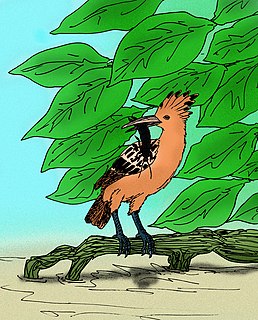
The Saint Helena hoopoe, also known as the Saint Helena giant hoopoe or giant hoopoe, is an extinct species of the hoopoe, known exclusively from an incomplete subfossil skeleton. It was last seen around 1550.

Labidura riparia is a species of earwig in the family Labiduridae characterized by their modified cerci as forceps, and light tan color. They are commonly known as the shore earwig, tawny earwig, riparian earwig, or the striped earwig due to two dark longitudinal stripes down the length of the pronotum. They are sometimes wrongly referred to as Labidura japonica, although said species is actually a subspecies, Labidura riparia japonica, found only in Japan. L. riparia are a cosmopolitan species primarily in tropical to subtropical regions. Body size varies greatly, ranging from 16 mm to 30 mm, with 10 abdominal segments. Males and females differ in forcep size, with males having much larger and stronger curve, while females have smaller, straighter forceps with a slight curve at the end. Earwigs use these forceps to assist in predation, defense, sexual selection, courting and mating, and wing folding.

Forficula is a genus of earwigs in the family Forficulidae. The best known species is Forficula auricularia.
Archidermapteron martynovi is an extinct species of earwig, in the genus Archidermapteron, family Protodiplatyidae, the suborder Archidermaptera, the order Dermaptera, and is the only species in the genus Archidermapteron, which simply means "ancient member of the Dermaptera". It had long, segmented cerci unlike modern species of Dermaptera, but tegmina and hind wings that folded up into a "wing package" that are like modern earwigs. The only clear fossil of the species was found in Russia.
Asiodiplatys is a monotypic genus containing the single species Asiodiplatys speciousus, an extinct species of earwig in the family Protodiplatyidae. It had long and thin cerci that were very different from modern species of Dermaptera, but tegmina and hind wings that folded up into a "wing package" that are like modern earwigs. Like Archidermapteron martynovi, the only clear fossil of the species was found in Russia.
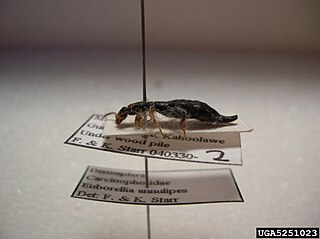
Anisolabididae is a family of earwigs, in the suborder Forficulina and the order Dermaptera. It is one of nine families in the suborder Forficulina, and contains thirty-eight genera spread across thirteen subfamilies.
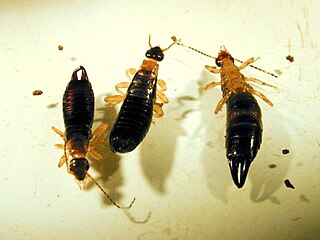
Euborellia is a genus of earwigs in the subfamily Anisolabidinae. It was cited by Srivastava in Part 2 of Fauna of India. Euborellia are small, dark-colored earwigs. Species can be difficult to distinguish from one another. There are about 50 species.
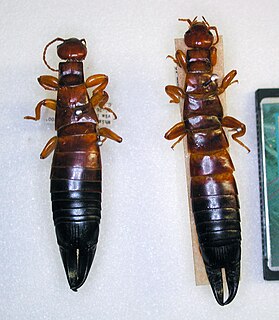
Titanolabis is a genus of earwigs in the subfamily Anisolabidinae. It was cited by Srivastava in Part 2 of Fauna of India. Among its species is the Australian T. colossea, which at about 5 cm (2.0 in) long is the largest certainly living species of earwig.

Diplatyidae is a family of earwigs in the suborder Neodermaptera. It contains only one subfamily, Diplatyinae, which contains six genera, five modern and one extinct known from fossils. The genus Tytthodiplatys was described in 2011 from a fossil found in Burmese amber which dates to the Albian age of the Cretaceous. It was not placed into the subfamily Diplatyinae, and is the oldest confirmed member of the family.

Labiduridae, whose members are known commonly as striped earwigs, is a relatively large family of earwigs in the suborder Forficulina.
Aborolabis vicina is a species of earwig in the genus Aborolabis, the family Anisolabididae, the suborder Forficulina, and the order Dermaptera. Found primarily in the Afrotropical realm, this species was first classified by Burr in 1911.
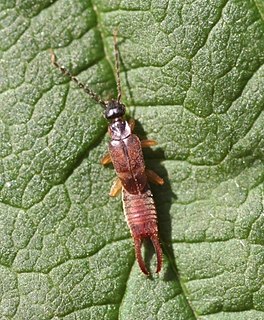
Labia minor, the lesser earwig or small earwig, is a species of earwig. It is widespread globally in temperate climates, preferring warm locations such as compost heaps in parts of its range. It is 4–7 mm long, including the pincer, and chocolate brown in color.

Astreptolabis is an extinct genus of earwig in the Dermaptera family Pygidicranidae known from a group of Cretaceous fossils found in Myanmar. The genus contains two described species, Astreptolabis ethirosomatia and Astreptolabis laevis and is the sole member of the subfamily Astreptolabidinae.

Tytthodiplatys is an extinct genus of earwig in the family Diplatyidae known from a Cretaceous fossil found in Myanmar. The genus contains a single described species, Tytthodiplatys mecynocercus.
Zigrasolabis is an extinct genus of earwig in the family Labiduridae known from Cretaceous fossils found in Myanmar. The genus contains a single described species, Zigrasolabis speciosa.
Toxolabis is an extinct genus of earwig in the dermapteran family Anisolabididae known from a Cretaceous fossil found in Burma. The genus contains a single described species, Toxolabis zigrasi.













